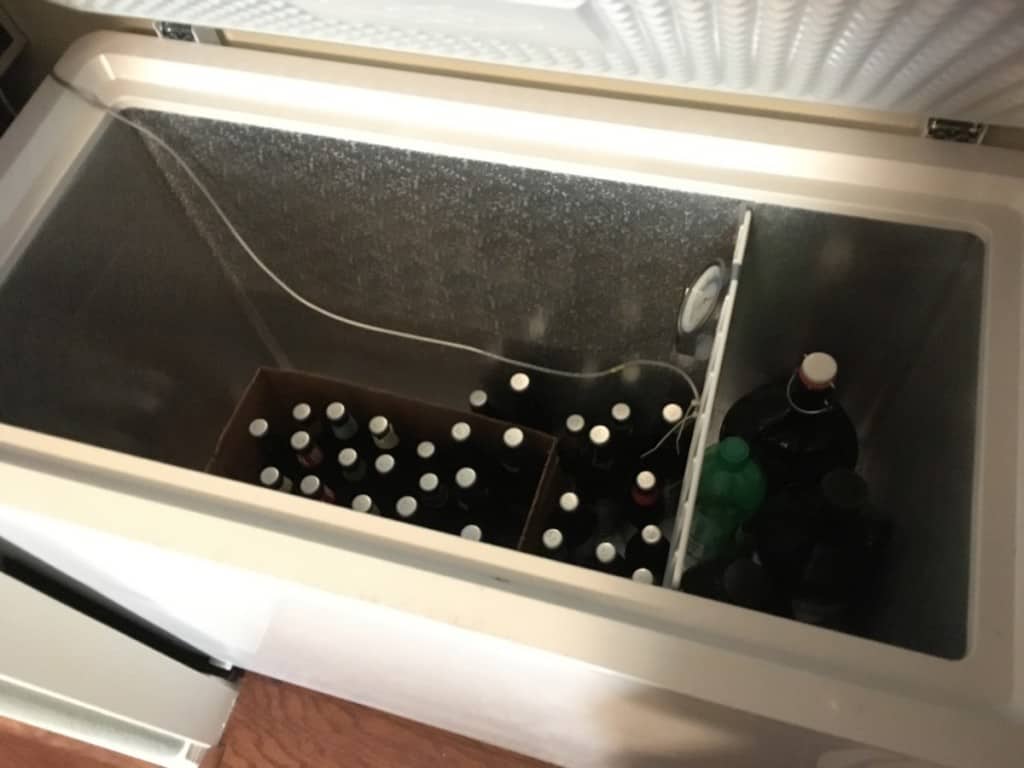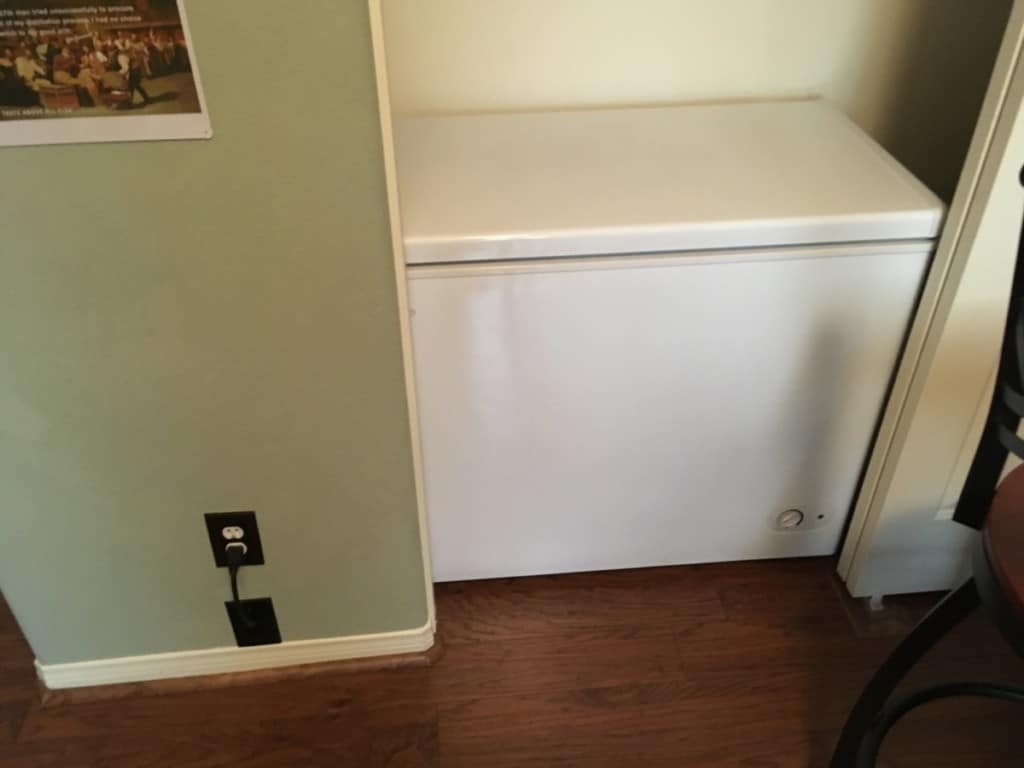Fermentation is the most critical part of homebrewing. It also takes the longest. So how do you store your beer for long periods of time and keep it from being disturbed?
Beer in the fermentation stage should be kept in a dark place with a consistent temperature. It should also be in an area that is easy to clean if spills occur. Low traffic areas are also important to maintain all of the above.
Fermentation will take the longest out of the entire home brewing process. Its important to get this part right. If you are new to home brewing there are simple locations around your house to store the beer. Some beer styles are more fickle than others and require different temperature ranges.
Storing Fermenting Beer in Your Home
Not everyone has the luxury of space. Lots of people live in tiny apartments, while others don’t have an area with a consistent temperature below are a few important factors to keep in mind while beer is in the fermentation stage.
Dark Location
This is one of the most important and somewhat easy to do. You basically just need to find space in your house that is consistently dark. Some examples include:
- Cupboard
- Basement (or windowless room)
- Closet
- Chest fridge or cooler (regulated ones are great)
- Corner of the room with towels or blankets
I particularly like the last one you can basically make a beer fort. Most of the above ones are also free. The chest fridge is the only one that costs any money. The chest fridge does offer a great way to keep it dark but also to regulate temperature.

Temperature
Temperature during fermentation is also very important. Different styles of beer use different types of yeast. You will need to make sure that you are storing your fermenting beer in a temperature that is consistent with the yeast strain you are using.
One difference is the fermentation range of an ale vs a lager. An ale will need to ferment at higher temperatures around 70 degrees Fahrenheit, while a lager will need to sit at lower temperatures around 50 degrees Fahrenheit.
This can make things a little bit difficult if your temperature varies wildly according to the location you have placed it. Many locations also never get down to those lager levels, so you might not even be able to store it in any of the above locations.
At the end of the day these are really just guidelines, as long as you keep your beer from the extremes of freezing and boiling you’re beer will ferment properly. The yeast will stay active and wont die off.
Don’t let temperature stop you from brewing your own beer, it likely won’t be as consistent but hey maybe you will discover some great flavors you didn’t expect.
Don’t Move it and Anticipate Mess
Even if you have a blow off tube going into a bucket or milk jug you could still end up with mess. That’s why I like to keep the beer around surfaces that are easily cleaned.
Again a chest freezer accomplishes temperature regulation, dark location and it’s easy to clean. It’s probably worth the investment if you are starting to get serious.
But if you are in a pinch you can keep it on any glazed or waterproof surface. This will keep the beer from soaking in and causing stinky problems in your future.
You also won’t want to move your home brew, you could end up getting more sludge from the rim back into your beer. This can produce some issues and create an off flavor, but even so don’t be too worried about it.
My buddy and I have gotten some of the scum into the beer when transferring to secondary and the beer tends to turn out fine. It may become a problem if you have a less flavorful beer, but hey why are you brewing beer if not for flavor?
Temperature Controlled Chest Fridge
I highly recommend investing in a chest fridge if you are brewing beer with any amount of consistency. It will protect your investment in materials every time.
Not only that but you can experiment with different types of beer at different temperatures. In addition you can change the temperature as the beer ages. This will perfect the flavor and bring out the most delicious esters you can possibly get.
Understand that there is one weakness to using a chest fridge. You might not be able to brew in the quantities you would like. You will likely only have room for 1 or 2 carboys depending on the size you get.

Anticipate Temperature
When the yeast is active in fermenting the beer it will warm of the beer in the process. This is why you need to anticipate the temperature of the carboy in relation to the surrounding air.
Some cheap tips to keep the beer from getting to hot on a summer day are to insulate the carboy with towels and keep some ice around it. The ice won’t be cold enough to put the yeast into dormancy and the temperature will regulate along with the activity of the yeast.
As less sugar is available the yeast will naturally enter dormancy and create less heat. Again I prefer the set it and forget it method so temperature control is my favorite method.
If you are using a chest fridge it is best to set the temperature lower when first putting the carboy in and then raise it a bit after you replace the blow off tube with a bubbler.
Save Energy
One hundred percent the best way to save energy is through temperature controlling a small space. You don’t want to cool or heat your entire house to make sure you are keeping the beer safe.
It’s also much less expensive to keep a small space cooler than it is an entire house.
A lot of things can go wrong if you are not paying attention while trying to save energy. If you go on a weekend trip and turn off your thermostat, the beer could be ruined in a heat wave.
DIY Route
You can google some pretty interesting fermentation coolers. try it out, search online for DIY fermentation chillers. I’ve seen some pretty crazy stuff like air pressure pumps being pushed into normal beach coolers.
Some of them can get pretty insane but if you are looking to keep the temperature regulated on a budget go look up some of those methods.
It will take some know how and will probably make your beer creating adventure a little more than you bargained for but if you are up to the challenge go for it.
Fermentation Length and Bottle Conditioning
Beer will take around 2 weeks to ferment in a carboy. It will take another 2 weeks if you decide to bottle condition. If you are skipping the bottle conditioning that in will be fermenting for a full month.
There is no official time for how long it takes beer to ferment. If the gravity does not change for 3 days in a row then it is done.
Fermentation is still taking place while you are bottle conditioning. It is the yeast after all that is creating the CO2 required for carbonation. This means that you also have to worry about the temperature of the beer when you are fermenting in the bottle.
Do not put your newly bottled beer in the cold fridge!
If you are putting your beer directly in the fridge after bottling you are giving the yeast a really hard time. It will likely go dormant and not produce that delicious fizz.
Bottle conditioning can be done for around 2-4 weeks. It also can sit at a higher temperature since most of the yeast has produced the flavor already. You are just trying to get it carbonated.
The temperature can be around 70-80 degrees Fahrenheit. You also don’t have to worry too much if you are bottling in brown bottles since that helps keep things dark. I would still store it in a dark location just to be safe though.
